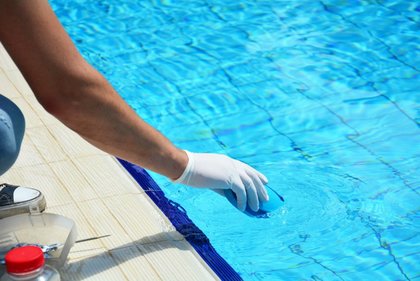Water Conditioning Devices for Swimming Pools and Spas

Wednesday, October 31, 2018
The Water Conditioning Device Task Group for NSF/ANSI 50 has worked hard over the last year to design, refine and implement a testing protocol to eventually be used for the certification of water conditioning devices.
What is a water conditioning device?
A water conditioning device (WCD) is any technology or device that, without the use of chemicals, can improve the water quality in a pool or spa. Many existing products fall under this category while still leaving room for innovation and growth in the field.
The test protocol currently includes guidelines for validating the performance of any product that makes claims regarding the improvement of the following parameters:
• Combined chlorine level of pool water
• Chlorine consumption for sanitizer level control
• Acid consumption for pH control
• Turbidity level of pool water
• Phosphate levels of pool water
• Consumption of water required for circulation system filter cleaning
The aim of these evaluations is to provide scientifically validated information to end users regarding the efficacy of product performance claims, allowing them to benefit from the possibilities of lower chemical costs, improved water quality and bather comfort, and smaller environmental impacts.
How are water conditioning devices tested?
The examination of water conditioning devices accounts for two factors: safety and efficacy.
The safety effects portion includes pressure testing, as well as evaluations of installation, warning labeling and safety mechanisms for swimmers and operators. Information regarding safety of the water conditioning devices allows facility operators to make informed decisions on product safety, reducing the potential for negative safety outcomes.
Performance claims made by manufacturers are evaluated in a controlled simulation of real-world conditions. Before the water conditioning device is installed, a large volume of clean water is chemically balanced and filtered to obtain standard pool water conditions. The pool water is circulated in a manner mimicking a swimming pool over a minimum period of one week, during which a particulate contaminant and a synthetic bather load are dosed into the water at regular intervals. The contaminant and bather load are designed to simulate the dirt, oils and bodily fluids that typically enter pool water from swimmers in normal-use conditions.
Automatic controllers are used to monitor and maintain typical pool water chemistry during this period, as well as to measure the amount of chemicals required. Also monitored: Water-quality parameters and the total water volume needed to clean the filtration system. All of this information is put together to create a baseline for water quality and chemical and water consumption comparisons.
After the one-week baseline period, the water conditioning device is installed and put into operation. The same process is used during this test period for the WCD, maintaining and monitoring water quality parameters and chemical consumption.
Once the baseline and test periods are complete, the measured water quality parameters and chemical consumption data are compared — to each other and against manufacturer performance claims for the water conditioning device under examination.
The device being evaluated must meet minimum reduction requirements and the manufacturer’s conditioning claim to pass testing.
When will certification be available?
The draft language of the test protocol for water conditioning devices is ready and awaiting a vote by the full NSF/ANSI 50 joint committee at the next meeting.
In the meantime, initial certification can be performed under NSF’s component certification specification CCS-18325: Water Conditioning Devices for Recreational Water Facilities. A CCS is a certification guidance document created for materials, components and products within the scope of NSF/ANSI 50, but for which no specific requirements are provided. Evaluation criteria are typically incorporated into the standard within two years from the date of certification.
How can I get a new product technology included for certification?
The Water Conditioning Devices Task Group has designed the language of the standard to be inclusive of the many different types of technologies in the pool and spa marketplace. If you manufacture a product that is not covered under the current standards language and would like to discuss options for certifying your product, please feel free to contact pools@nsf.org for more information.
Want to get involved in the Water Conditioning Device Task Group? Contact NSF at standards@nsf.org or visit our public portal for the joint committee on NSF/ANSI 50.